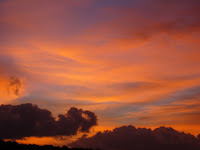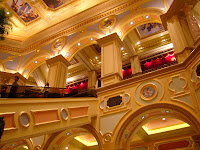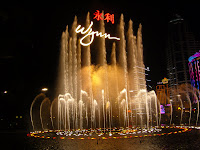
One nice side effect of my being in Singapore is that it is bringing people to Asia, those who normally might not have traveled to this bustling region. (This makes it sound like a small area - in fact, "Asia" is huge. A trip from Singapore to Tokyo - next door neighbors, right? - is essentially the same as that from Washington, D.C., to London.)
Mom and Dad made their inaugural visit over here earlier in November, with an ambitious itinerary that took them through Taipei (for layovers), Hong Kong, Bangkok, southern Thailand and peninsular Malaysia, Singapore, and Bali. They would stay with me in Singapore, but I decided to join them for a couple of days in Bangkok, as it had been a while since I had visited.
They had been in Bangkok for a day when I arrived after 8pm on Friday and apparently had already had some interesting experiences (I'll leave them to tell you). I met the two at our hotel, the Shangri-La, which is right on the river, the Chao Phraya. After a bit of downtime, we headed out to eat.
I had chosen a restaurant named Ruen Mallika from a Wallpaper guidebook. The restaurant is in an old teak house, which is situated in what looks like an alley, and even the taxi driver was not sure how to get there. After an in-transit call to the restaurant (we found that this is quite popular in Bangkok), he found it, and we were in for a nice Thai meal. Mom and Dad let me order, but I went light on the spices. The night was old by the time we finished, so it was off to bed.
The next morning, we headed to the river for a trip up to Wat Arun (the Temple of Dawn) and the Grand Palace. It was hot already, but a cool breeze blows along the river, especially in the boat as you make your way north. We got off on the east side of the river and took a ferry across to Wat Arun.
I have written about this temple before, but it always strikes me how steep the climb is as you get to the higher levels. The first bit is bad enough, steep and without a handrail. The next two levels get remarkably steeper, although you do have a rail on which to apply a vice-like grip as you ascend. We got to the next-to-top level, and Mom and Dad decided that was as far as they would go. I grant you, it is nerve-wracking, the last staircase is so steep. But, I had been up there before, and I knew it was worth it. So, I told them I was going up and appealed to Mom's sense of determination (something about "you're only going to be here once" and "remember how you got to Strawberry Lake" - you'll have to ask her on that one), and I headed up. I circled around to look down and say hello, and lo and behold! They were on their way up! It is scariest at the very top of the stairs, because the platform tilts just a little bit towards the ground, and it is nearly a sheer drop to the next level. But, once you step away, it is not bad, and the views are spectacular. And even the trip down is not as bad as the trip up, as you just grip the handrail tight and take one step at a time.

After that, we headed back across the Chao Phraya for the Grand Palace. We had been warned about con artists trying to tell you that certain attractions were closed, trying you go visit attractions with which they were affiliated. And we were approached by one as soon as we got off the ferry, but we ignored him and started walking north to the palace entrance. We weren't quite sure where the entrance was, however. The grounds are massive, and we had been walking across from the palace walls since getting off the ferry, but no entrance was in sight. We must have looked confused, because a badge-carrying member of the "Tourist Police" approached us to help. He was very persuasive that the palace did not open until 2.00 pm, and showed us a couple of other sites that he claimed were of interest, open to foreigners (a key claim for many con artists), and free of charge. Well, we were convinced. Not to visit the other sites, but to go somewhere else first and then come back to the palace. Fortunately, just as this fellow was leaving us, two Americans we had run into at Wat Arun walked by and told us to not believe anyone, that they didn't, and that they were going to the palace. Sure enough, we walked around the corner, and there was the entrance. I was so angry! I couldn't believe we had been duped, but we still had all our money, and we had been lucky. I did look for our friendly "Tourist Policeman" as I walked back, but I didn't see him.
The Grand Palace was built beginning in 1782, to mark the founding of Bangkok as the new capital (Bangkok, or Krung Thep - city of angels - is a relatively young city) and provide a residence for the king (Thais love their king, who doesn't look anything like Yul Brenner). It also houses the Wat Phra Kaeo, the resting place of the sacred Emerald Buddha, a 600-year old jadeite image of the Buddha. It had several homes before it was brought to Phra Kaeo in 1785. The statue itself is housed in a bot, a brilliantly-colored building at the eastern end of the grounds. Tourists are not allowed to take pictures inside the building, and you are instructed not to point your feet at the Buddha.

While the bot is the most important building in the wat, it is by no means the only sight worth seeing. The grounds are filled with beautiful structures, from the gold-covered spires of the Phra Si Rattana Chedi, which contains a piece of the Buddha's breastbone, to the green-hued Phra Mondop, the library, to a Khmer style stone tower. The craftsmanship and attention to detail are amazing here. You could spend all day just staring at the buildings. But, it was blazing hot, and after a while, we were ready to head back.



I wanted to see Wat Pho, which contains a large reclining Buddha, but Mom and Dad wanted a rest and headed back to the hotel. We actually had walked right by Wat Pho when we first got off the boat, and it wasn't hard to find. It is a nice site, quieter than the Grand Palace but still providing a feel of grandeur. The reclining Buddha is massive, and the grounds hold many interesting structures. And around the back of the Buddha, there is a row of pots that people line up to drop coins in (you change some baht for small coins). I don't know what the significance of this is, but I participated, if only for the sake of karma.


Dad wanted to stay at the hotel and swim when I returned, so Mom and I went to the Jim Thompson House. Thompson was an American who was stationed in Bangkok after World War II as head of the OSS office there. He became fascinated with the ancient art of Thai silk weaving, which had disappeared during the war, and he very successfully revived it. He became well known in Bangkok not only for his silk company, but also for his home. He brought six individual houses from remote parts of Thailand and re-assembled them into a sort of compound, locating it on the banks of a khlong, a finger of the river that run through the city. Just across the khlong was the Bangkok silk works, which he helped develop and continued to patronize for his supplies of silk, which were woven into his now world-famous garments.
Thompson mysteriously disappeared in 1967 while vacationing in Malaysia, and his legend has grown ever since. Not only was he a charismatic man, but he had good taste in art and in design, as evidenced by his extensive collection of Asian art and the style of his house. The house is mainly in dark wood, a mix of open, airy rooms and smaller, peaceful spots like his study and the dining room. It felt very lived-in for a museum, and it was a nice respite from the hustle and bustle - and heat - of the city.

Mom and I took the skytrain back to the hotel and the three of us enjoyed a nice Royal Thai meal, complete with traditional Thai music and dancing.

I had an early flight on Sunday, and they had to prepare for their train journey through Malaysia to Singapore, so we said goodbye, and I was on my way to get ready for their visit to the Lion City.



















































